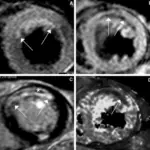Fat embolism is a rare form of embolism that often results from multiple fractures or a fracture of the femur. Fat droplets enter the vein from bone marrow or surrounding adipose tissue.
What is the Pathology of Fat Embolism?
The pathology of fat embolism is:
-Etiology: The cause of fat embolism is trauma with long bone fractures, extensive soft tissue trauma, burn injuries, severe fatty liver, and very rarely with orthopedic procedures.
-Genes involved: None.
-Pathogenesis: The sequence of events that lead to depot-derived fat embolism arises by disruption of depot fat, usually as a result of trauma, allowing direct entry into the bloodstream. Plasma-derived fat embolism is caused by agglutination of endogenous or infused exogenous fat such as Intralipid, with consequent embolism.
-Morphology: The morphology associated with fat embolism shows platelet activation and granulocyte recruitment (with free radical, protease, and eicosanoid release), complete the vascular assault
-Histology: The histology associated with fat embolism shows microscopic fat globules, fat and marrow emboli
How does Fat Embolism Present?
Patients with fat embolism typically affect males present at the age range of 20-30 years. The symptoms, features, and clinical findings associated with fat embolism include rapid breathing, shortness of breath, mental confusion, lethargy, coma, petechial rash, fever, and anemia.
How is Fat Embolism Diagnosed?
Fat embolism is diagnosed using Gurd’s criteria (petechial rash, respiratory distress, mental concussion).
How is Fat Embolism Treated?
Fat embolism is treated using supportive care, supplemental oxygen, heparin, and steroids.
What is the Prognosis of Fat Embolism?
The prognosis of fat embolism is fair with almost 80% of people fully recovering with no lasting side effects.



